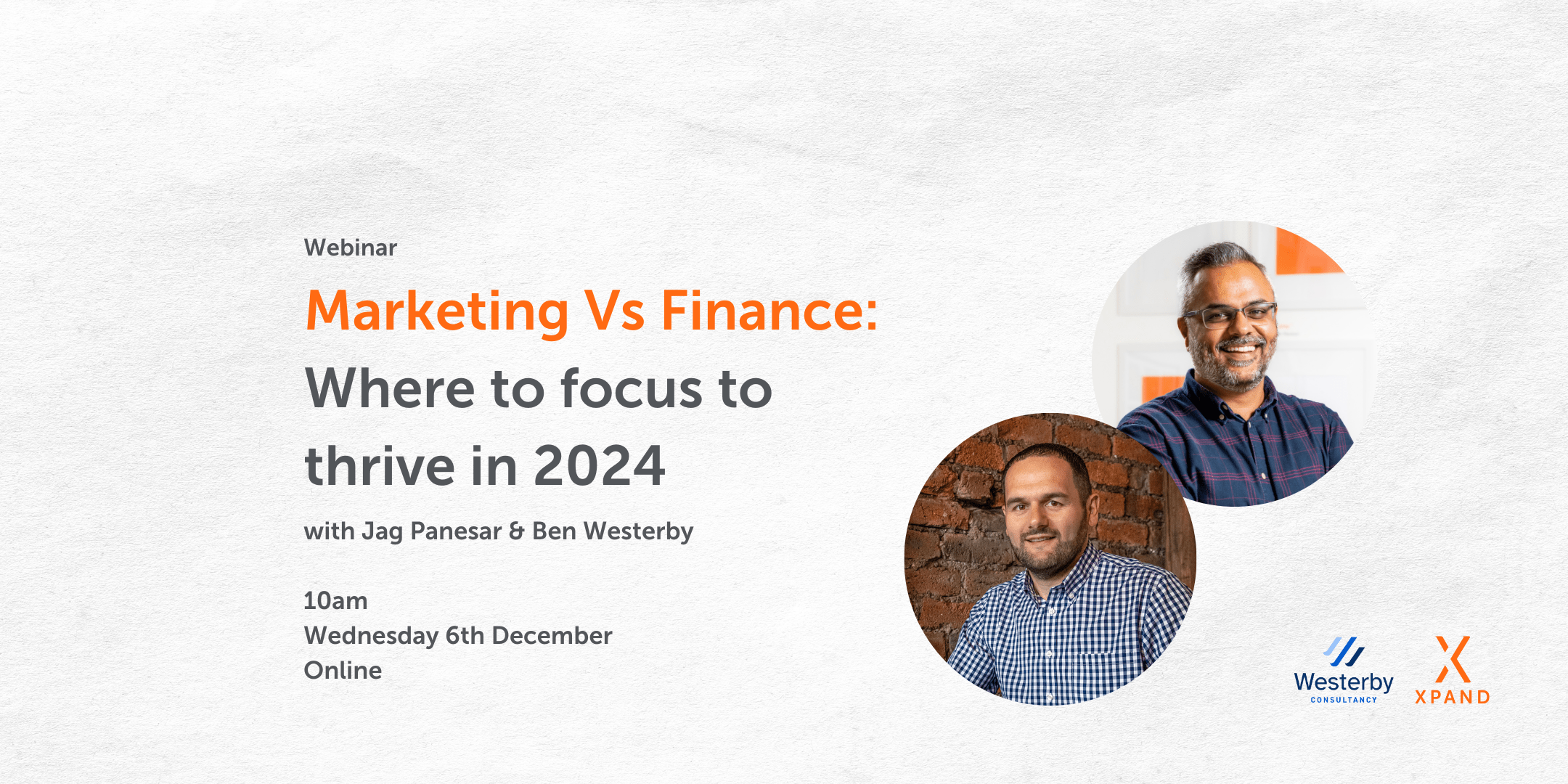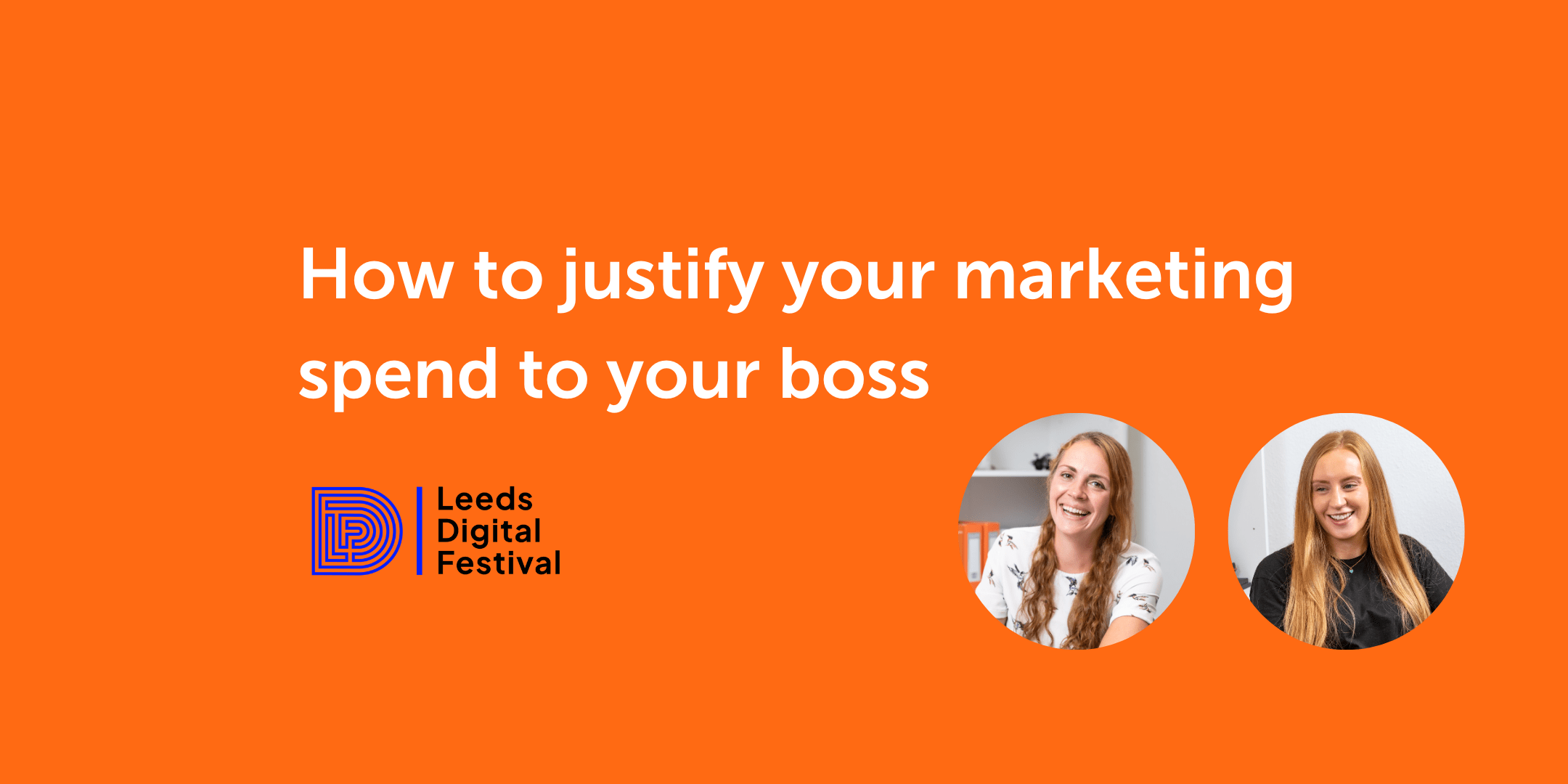The amount of time we're spending on social media is rising, which is changing the way we're using it. In this webinar, we discuss how this change could potentially diminish the need for a website.
Did you know that social media usage has increased by almost 100% in the last 5 years? That’s nearly 1.5 billion new users.
So, if your business isn’t active on social media, you’re missing out on an opportunity.
In this webinar, we will cover:
- Our future predictions of how social media will change as a marketing tactic
- Why social media is crucial for business growth in 2021
- Each BtoB social media platform and how it can be used
- How to future proof your digital marketing strategy
- Useful tools you can use to strengthen your digital marketing strategy
In the past, customers have predominantly used websites (and maybe a Google search) to do their research for making a purchase. However, with the growth of social media in the last 5 years, it’s no surprise that the buying process has changed.
75% of customers are now saying that they use social media as a part of the buying process. Therefore, if you’re not using social media to promote your business, you could be taking yourself out of the running early on.
When you consider how fast social media is evolving and adapting to be more suitable for E-commerce and promoting your business, it makes sense that we’re questioning whether social media is going to be just as important as your website.
Our future predictions of how social media will change as a marketing tactic
If you think back to what social media was like over 10 years ago, the ‘like’ button on Facebook didn’t even exist. These platforms are also a lot better equipped to put content in front of you that you’re interested in rather than having a news feed full of your friends’ Farmville updates.
We predict that this evolution will only continue, especially with the catalyst of Covid-19 forcing brands to find new ways to communicate with their audiences.
Our other predictions are as follows:
1. Could social media sit at the heart of your marketing model?
The SOLAR 7 model shows your website to be at the heart of the model i.e. this is the central point that people touch base with to assess your credibility before they enquire.
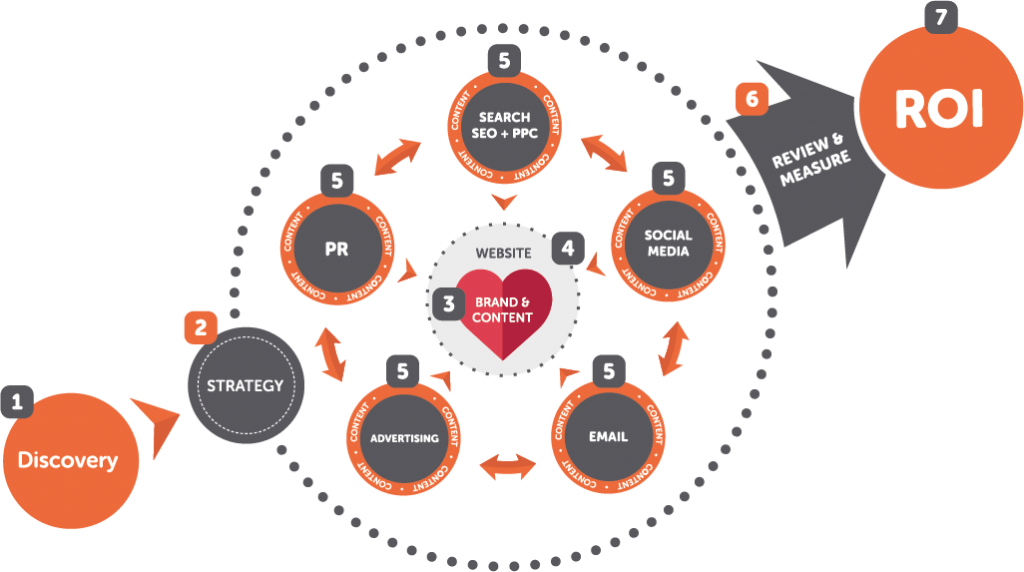
A few weeks ago I ran a LinkedIn poll asking the question: You’re looking for a BtoB supplier. Do you enquire just from seeing their social media or do you need to check their website too?
The results were as follows:
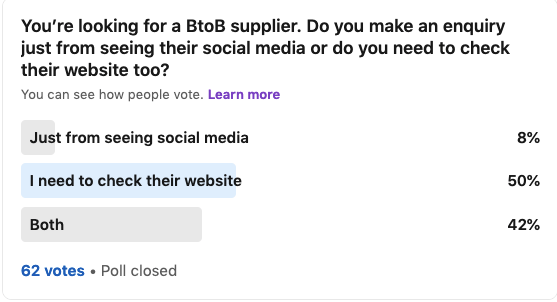
50% of the 62 people that completed the poll said that they need to check your website as well as your social media before deciding whether to contact you. 8% said they would enquire just from seeing your social media.
If we add those two percentages up, we’ve got a whopping 58% of people saying that social media is important to their decision-making process when enquiring, that’s more than half of the surveyed people!
What does this mean? Social media is becoming more prominent. 10 years ago, we would guess that this percentage would be significantly lower as it was nowhere near as prominent as it is now.
The question is, what will this percentage look like in the next 5 years?
What this tells us is, in the SOLAR 7 model, rather than having your website at the centre of the model, maybe your social media could be there as a central contact point?
But rather than calling it ‘Social Media’, if we label it ‘Home’, that pushes the boundaries of the model and shows that any other kind of digital platform could be the central place that houses your key company information.
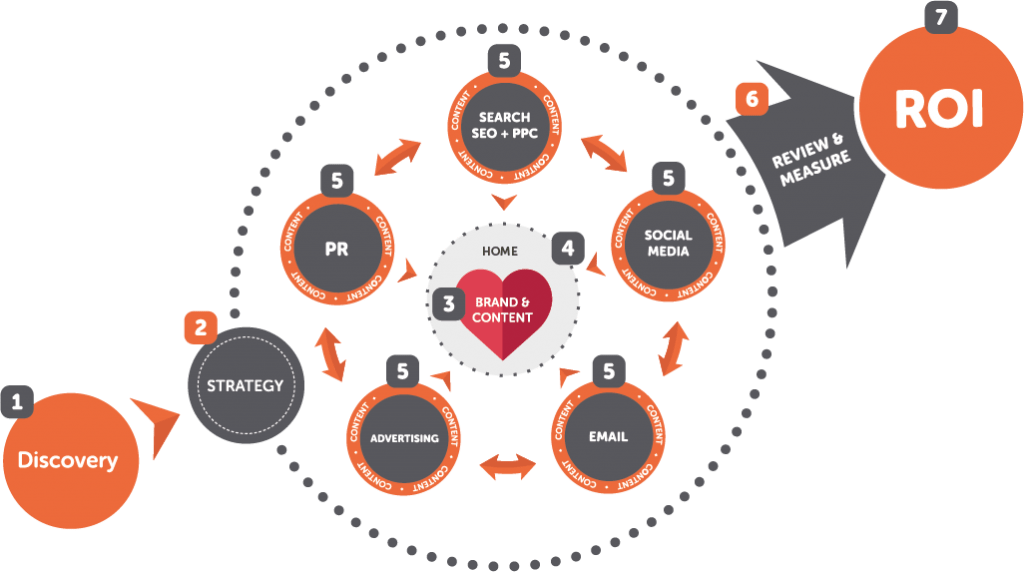
We’re not saying websites will cease to be important. For the foreseeable future at least, we think websites will always play an important role, though the way people use them will change.
A strong social media presence with consistent, target audience relevant content in your brand’s tone of voice is, therefore, in our opinion, paramount to the success of building your brand and gaining enquiries.
2. Value-adding content will take the lead
Previously, we’ve seen brands post for the sake of meeting the platform’s algorithm, meaning they’re not always posting quality content.
The Covid-19 pandemic forced brands to question whether this method was appropriate during such a sensitive time, which we think will continue moving forward. Customers are wanting to see content that brings them value so it’s important to consider this when you’re planning your content strategy.
When working BtoB, your audience wants to be convinced you know your stuff, so educate them. You can do this by writing blogs, e-books, reports, and creating how-to videos. The BtoB buyer will usually do their research before making a purchase, so this activity helps to support their journey with your brand.
Focus on delivering valuable content to your audience on social media to strengthen your strategy moving forward.
3. Video will continue to take centre stage
Video content is now one of the most engaging forms of content and it’s predicted that by 2022 82% of all online content will be video. So if you’re not currently using video, you should consider including it within your future content strategy.
With social media platforms increasing their video capabilities, this prediction is strengthened. The likes of Instagram Reels are allowing even the least experienced content creators to produce video content that looks professionally made. BtoB brands that are experimenting with these features and finding new ways to educate and add value to their target audience will stand out among the competition.
It’s also worth noting that LinkedIn now has two algorithms- yes two! Which are separate for mobile and desktop. The mobile algorithm now favours video content as LinkedIn has found that mobile users are more interested in viewing this type of content. So, we suggest looking at your Google Analytics to understand the percentage of your website traffic that uses mobile. This will give you a good indication of whether you should create your content to work with the mobile algorithm or the desktop algorithm.
4. Social media channels could double as shopping channels
Facebook and Instagram have taken the lead with their integrated shopping feature which allows users to purchase without leaving the app, contributing to a good user experience.
This led us to question whether having a social media platform would soon become as important as having a website. Think about it, if you aren’t having to leave the social media platform to make the purchase, the step of going to the website has been completely boycotted.
What do we predict this will mean for the future?
We don’t believe that this means websites are going anywhere anytime soon, especially in the BtoB sector. But, we do think that as social media continues to evolve its features to match that of a website, you will need a stronger social media presence. Therefore, we suggest that if you’re not currently investing time/ money into a social media marketing strategy, now’s the time to start. as social media becomes more versatile and the demographic of your customer changes to be more in tune with the digital world.
5. Authenticity will be vital
Over the past year or so, your customers have faced a global pandemic which has caused financial uncertainty and general concern across the globe.
Customers are wanting to feel as though they can find trust in the brands they’re purchasing from. To reach those customers at the top of the funnel, brands have been adopting a more human personality on social media to become more authentic.
You could do this by sharing user-generated content (content created by your customers and posted on their social media profiles) or sharing customer testimonials. This is becoming increasingly valuable to the modern customer as it’s a great way to build trust and pull them further along the funnel to the purchase stage.
6. Personalisation is key
This trend has been around for a while now, and it works. But it’s a relatively new trend used in social media.
Arguably, you can’t personalise your organic social media content for your target segments because it’s available for anyone to see. However, you can achieve this through your paid advertising by refining the segments your ads target.
Advertising on social media has got to a level now where you can learn about your audience by the people interacting with your ad. This will help to increase the level of personalisation you can deliver.
Creating personalised content will help to strengthen customer loyalty and brand affinity. Think about it, personalised messages are going to make your audience feel as though you recognise their needs. This positive interaction with a business is more likely to increase their loyalty or the chance of them being converted.
If you’re looking to experiment with paid advertising but are unsure where to start, take a look at our recent webinar by our Digital Marketing Manager, Danni Johnson where she discusses ‘How to boost the success of your social media advertising.
7. You need to re-evaluate the metrics that are considered important
Many brands begin to use social media with no real objective. This often leads to them chasing popularity in the form of vanity metrics, thinking that this is what accounts for success. When we use the term ‘vanity metrics’, we’re talking about a page’s followers, likes on a post and basic interaction with content. However, as we have said before, social media is evolving meaning that the way we measure success on the platform is changing too.
It’s time that we stop focusing on how many likes we can get on a post, and instead consider the data that highlights the success of your social media campaign on your bottom line.
Instagram is ahead of this movement with their recent announcement that they’re now giving users the option to remove the likes count from their feed. Arguably, they have done this to save their reputation after being branded the worst platform for harming young people’s mental health. But, if Instagram is willing to remove the feature, it suggests how little impact it has on the success of a post. Considering how quickly platforms are to adopt popular changes from competitors, we expect to see this change filter through to the other social media platforms.
So if you’re not focusing on vanity metrics, what are you looking for? Focus on the sales funnel.
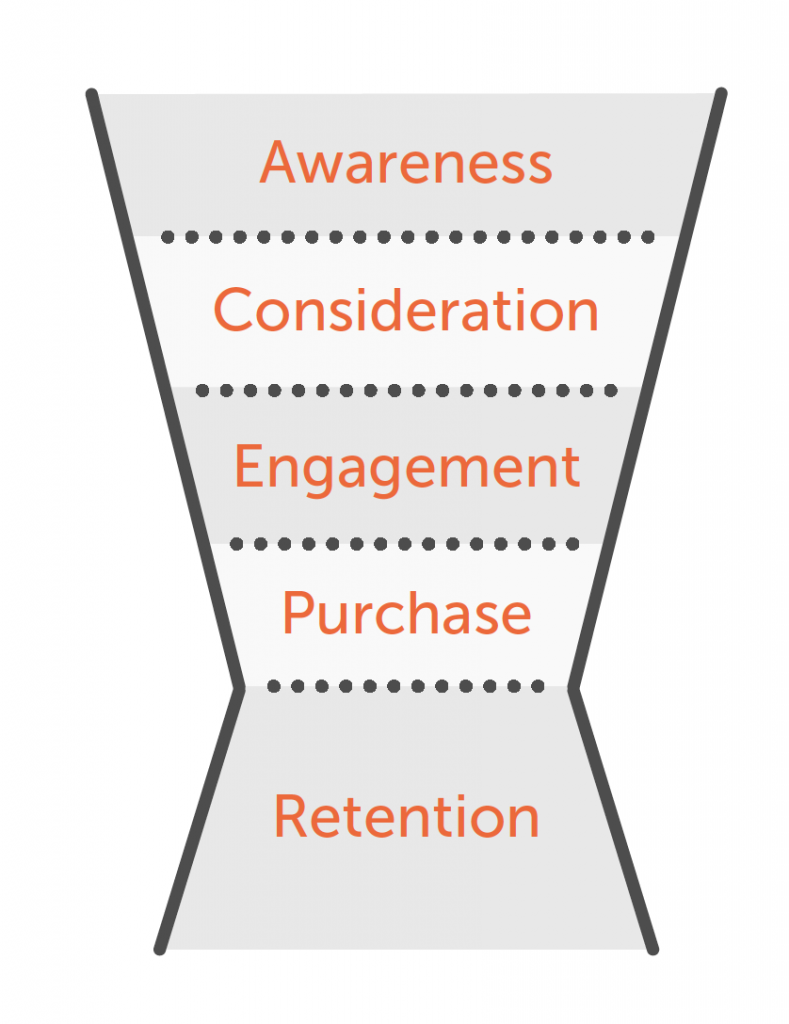
If creating brand awareness is your objective, you might focus on your post reach, how many mentions you’ve received and how fast your audience is growing.
Alternatively, if your objective is to increase customer engagement, you should focus on metrics such as your average engagement rate and your amplification rate (the number of your followers sharing your content through your social network).
If conversion is your objective, focus on your conversion rate, click-through rate, bounce rate and traffic from social media to your website. This will help to give a clear picture of whether your conversions are coming from your social media channels.
Why social media is crucial for business growth in 2021
We now have 4.2 billion active social media users around the world with each person spending on average 2 hours and 25 minutes a day just on social media. Regardless of the industry you work in, social media is an essential component of your marketing strategy.
In short, using social media can help you to:
- Connect with your audience to form long-lasting relationships
- Increase brand awareness
- Reach wider audiences
- Create and personalize content to increase customer loyalty and engagement
- Learn about what your competition is doing
1. You can be omnipresent
Another benefit of using social media is that it allows businesses to be omnipresent, and with the average person having around 8 social media accounts, you’ll appear to be everywhere and your chance of being noticed is increased.
This supports the rule of seven. If you haven’t heard of this before, the rule states that you need to see a brand’s message at least seven times before you decide to purchase from them. Social media is a great way of achieving this.
2. Social media adds credibility to your brand
Like we’ve said before, a large proportion of us are checking a brand’s social media account before making a purchase.
Social media is a great place to gain reviews. If new customers are coming to your website and seeing that other people are happy with your product/ service, they’ll be more confident in purchasing from your brand. This is an example of social proof, whereby people are more likely to copy the actions of others if they believe their actions are right.
In contrast, every review you get might not always be good. But, because you can reply to the reviews on your page you can manage your reputation by responding to the situation, which can also be seen by potential customers. Based on your response, the negative review may have little impact on your customer’s decision.
3. It can help you to build your personal brand
“Your brand is what people say about you when you’re not in the room”
Jeff Bazos When you’re working BtoB, building your personal brand can be very valuable for building credibility, awareness, and adding a human element to your brand.
You can use your personal social media to talk about your expertise in your field, which will positively reflect on your brand. For example, our Digital Marketing Manager Danni Johnson frequently takes part in external podcasts and webinars to extend her knowledge to wider audiences outside of our client and follower base. This has had a positive impact on our business and helped us to gain several new clients off the back of it.
When building your personal brand it’s also important to be omnipresent, just like a brand. This will allow you to consistently push content out to your audience, wherever you are and will help to solidify your expertise and passion for the industry. Remember, people buy into people and building your personal brand will help to achieve this.
4. Create relationships and build a community
The layout of social media now allows you to get closer to your audience than ever before, even the ones who aren’t following you. Take ‘groups’ for example. Users on Facebook or LinkedIn can join these communities of people with similar interests to them.
But how does this benefit your business?
Whichever industry you work in, there will always be groups on these platforms that consist of your target audience. This allows you to join the group, listen and respond. Not only will this get you on your audience’s radar, but it will also increase the credibility of your brand.
Another way you can achieve this is by becoming an industry leader. If your brand is seen to be sharing new industry trends, news and posting thought leadership style content, then your audience is more likely to trust what you’re saying and come to you in future to solve any queries.
Each BtoB social media platform and how it can be used
We know that social media can be a minefield. It almost feels as though there’s always a new update or feature to learn about. When you’re looking after so many other areas, it’s hard to keep up with it all.
In this next section, we’re going to look at each BtoB platform and how you can use its features to help grow your business. First up, LinkedIn…
LinkedIn is the world’s largest professional network on the internet. Businesses can use the platform to grow their network and brand presence.
- LinkedIn Analytics – Here you can monitor the progress of your page and posts. This is important for understanding what content is performing well, to help you get a better understanding of your audience.
- Events – You can now set up events through LinkedIn which your followers will be able to find on your page and sign up to.
- LinkedIn Live allows you to build deeper connections and drive more engagement with the world’s largest professional community. Live videos get, on average, 7x more reactions and 24x more comments than native video produced by the same broadcasters.
LinkedIn features you need to know about:
There are four other features you should be aware of, which you can read more about on our blog here.
What LinkedIn is good for:
LinkedIn allows you to connect with new audiences professionally, as well as assisting the digital networking process. You can use it to monitor what your competitors are doing and get a better understanding of your audience’s behaviour.
Facebook, it’s one of the longest standing social networks. It allows you to reach and engage with your audience without the spend (unless you’re looking to invest in paid ads).
Facebook features you need to know about:
- The Ads Centre- Here you can run specific campaigns through the use of paid advertising. Paid advertising allows you to select your goal and create a target audience that will see the ad. You can adjust your budget to suit the forecasted ROI (Return On Investment), but don’t forget to start by warming the audience up. Many of these may not have heard of your brand before, so don’t go straight in for the kill. Advertising on social media takes a lot of planning and time so don’t be afraid to seek expert help.
- Facebook Shops- If you have a product to sell, this is a great feature. You can set this up directly through your business page and it will allow you to start selling straight away. Facebook is consistently updating to be stronger in E-commerce.
- Communities – This is an additional tab on the page offering you a direct line with your customers and/or audience. Here is where your UGC (User Generated Content) can be formed.
In addition to this, there are five other features that you should be aware of, which you can view in our blog here.
What Facebook is good for:
Facebook is making some great changes to the platform to be better suited for businesses to sell their products, making the buying experience easier than ever before. It’s also good for building communities and facilitating engagement with others in your industry and potential customers.
Twitter is a micro-blogging platform that allows users to post short updates limited to 280 characters. The most successful users don’t just ‘tweet’, but use the platform to engage with other users. When operating a business account, you can use it to engage with audiences within your sector, by encouraging discussions or requesting feedback from your customers.
Twitter features you need to know about:
- Twitter Polls- Use the poll feature to gain a better understanding of your audience, or just for a bit of fun. This is a great way to encourage more engagement from your followers.
- Twitter Lists- This is a curated group of Twitter accounts. You can create your lists or follow others. Viewing a list timeline will show you a stream of tweets from only the accounts in that list.
- Spaces – this is a place to come together, built around the voices of the people using your Twitter community. Spaces are live for as long as they’re open; once ended, they will no longer be available publicly on Twitter.
And there are plenty more features to read about in our ‘social media for business in a snapshot blog’, here.
What Twitter is good for:
Twitter is where brands feel as though they can truly show their personality. The 280 character limit allows for brands to be sharp, witty and to the point. There’s a lot of development happening with Twitter at the moment, with monetization moving forward, the opportunities for businesses on this platform are growing.
Instagram is a simple and economical way to put your brand out there for the world to see. Even though it takes time to develop a huge following, once you do, the benefits can be great for your business.
Instagram features that you should be aware of:
- Instagram Stories – create stories that will disappear after 24 hours. This is a good place for content you don’t want on your normal feed.
- Instagram Reels -A new way to create and discover short, entertaining videos on Instagram.
- Influencer marketing- Instagram is the social hub for influencers, so if this type of marketing will benefit your business, it’s a great place to start.
There are many other Instagram features you need to know about for your business. To see the rest, go to our ‘social media for business in a snapshot blog’, here.
What Instagram is good for:
Instagram is a platform that inspires creation. You can bring your brand to life through imagery and video. The introduction of Stories now allows brands to be more ‘off the cuff’ with posting, as they don’t affect the aesthetic of their feed.
YouTube
Every day, YouTube users watch over a billion hours of YouTube videos and yet only a handful of small businesses have started their channels. As YouTube usage continues to soar, the opportunity is getting bigger for businesses ready to jump in.
YouTube’s features that you should be aware of:
- Use channel art to show off your brand’s personality.
- Create a Channel Trailer for your homepage to engage new audiences.
There are more Youtube features that you should be aware of that will benefit your business, just go to our blog here to view them.
What YouTube is good for:
YouTube is a great educational tool. You can use the format of video to communicate with your audience and share your expertise. This is a great way to build a strong relationship with your audience.
How to future proof your digital marketing strategy
Use your data
All businesses have access to a wealth of data. It’s how you use it that can benefit your business the most.
Any good marketing strategy needs to have clear objectives that are measurable against KPIs (key performance indicators). These help to indicate a campaign’s performance, for example, your objective might be to get more sign-ups for your newsletter. Whatever the goal is, your KPIs should be helping to support the objective.
Data will help you to get a better understanding of your audience
One of the most important roles of data is to understand who your audience is and who you should be targeting your marketing campaigns to. This is true for both your website and your social media channels. There is so much data now available, through Google Analytics and social media platforms analytics that can show you who is visiting your website/ profile. You can then use this information to build audience personas to help deepen that understanding and continue to create content that best targets your customers.
Targeting the right keywords
Your data can help you to understand what your audience is searching for when they’re looking for your service/ product. You can then use this information to target those keywords in your content and drive more traffic to your channels which will also support your business’s SEO initiatives.
Create value-adding content
Gone are the days that businesses just churned out content for content’s sake. As a result of the pandemic, brands are focusing more on creating content that adds value for their audience.
This goes back to having an understanding of your audience and what’s valuable to them, which will provide the basis for the content you need to create and how frequently.
A study by Microsoft has concluded that the human attention span has dropped to eight seconds, meaning that it is now more difficult than ever for brands to stand out through the noise. This solidifies the need for creating attention-grabbing content that’s relevant to your audience.
It can be hard to know straight away what content will resonate with your audience, so often trial and error is needed, along with using your data to get a better understanding of your audience’s demographics. However, a starting point for creating valuable content is:
- How to guides
- Webinars to educate on an area of your expertise
- Panel discussions with an expert in your field
- Thought leadership blog posts
- Reactive content that discusses what’s new in the industry
Give your brand the best chance possible of standing out by taking this approach with your content. ‘Doom scrolling’ is happening more frequently, where people are mindlessly scrolling through their feed, barely paying attention to the content in front of them. You need to find a way to stop the scroll and grab the attention of these individuals. Remember, whether you’re marketing BtoB or BtoC, you’re always marketing to real people at the other end of the screen.
Content doesn’t always have to be created internally. UGC (user-generated content) holds a lot of value for today’s customers. For example, reviews and customer testimonials are a great way to build brand trust.
Getting clients to leave reviews is always a challenge, but if you can encourage this it will contribute to building your prospects’ confidence in you, which will help to move them down the funnel closer to the purchase stage.

Monitor what your competitors are doing
Be honest, are you taking time to sit down and look at what your competitors are doing?
If this isn’t something you do regularly, it’s an area we’d recommend strengthening.
It’s good practice to:
List at least 3 of your competitors.
And then, list at least 3 benchmark companies of a similar size to you that you don’t 100% compete with.
Go on social media and have a look at their profiles.
For each one, assess the following:
- No. of followers/ likes
- No of posts per day
- Shares per post
- Comments/replies per post
- Hashtags per post
- Type of content they post. Is it:
Then, when you next create your content calendar make sure you schedule in content that has taken inspiration from what is working for your competition (but better). After all, you’re competing for the same audience, so in theory, it should resonate with the people interacting with your brand.
Review and measure always
This is the final stage of our 7-stage marketing process, and without it, you’ll struggle to see where you’re going wrong (or right) to improve your future campaigns.
You want to make sure you’re looking out for:
- No of enquiries
- No of proposals/ quotes written
- The total value of quotes/ proposals sent out
- No of sales
- Value of each sale
If you’re just blindly putting out content without frequently reflecting on what’s working and what isn’t, you’ll struggle to improve your digital marketing strategy.
Tools we recommend for improving your digital marketing strategy
Google Analytics
Google Analytics is great for uncovering valuable data about your audience to understand which channels drive most of the traffic to your website. You can monitor the audience section to understand the demographics of the people visiting your website. This will help you to strengthen your audience personas, and the more in-depth information you have on these profiles, the better equipped you’ll be to create content that resonates with them.
Social media insights
Every platform has its own insights section. You should monitor these to get a good understanding of the demographics of your audience so you can craft your content accordingly. This will also indicate which content is getting the best reach. This is another beneficial metric to track to understand the most effective content.
Rival IQ
This is a great tool for competitor research, which is free to use. You can use it to compare your social media to your competitor’s social media in terms of followers, engagement, and how often they’re posting.
Unfortunately, you cannot use this tool for LinkedIn as it’s a protected site but, as I have said, it’s a good place to start and will help with strategic planning.
Canva
We’ve recommended that you focus on creating content that stops the scroll, but how can you do that if you have no previous experience? Canva is a great tool for beginners who are looking to create engaging content easily. There is a free version if you’re not looking to invest in this area of your business yet, and this will give you access to several tools and stock images that you can use to make your social media feeds more engaging.
Xpand’s free guide to social media best practices
We have created a free downloadable guide to help you understand the best practices for social media. We know how hard social media can be to keep on top of, so we’ve included the best times to post for each platform and some of the features you should be aware of to really take your social media marketing to the next level.
We hope that you’ve found this webinar valuable. If you’re looking for any further support in strengthening your digital marketing strategy then don’t hesitate to get in touch.

